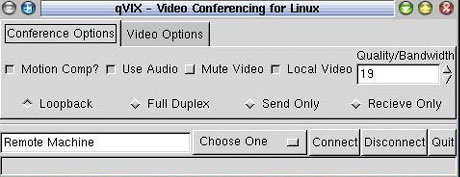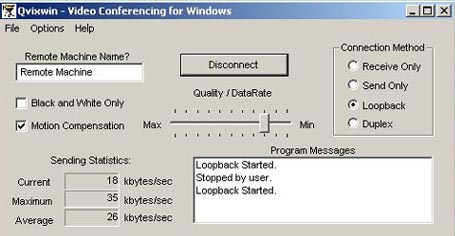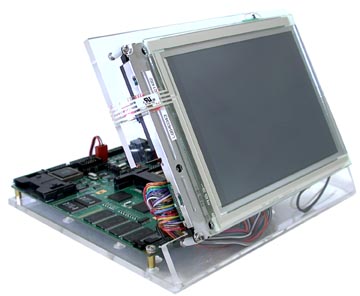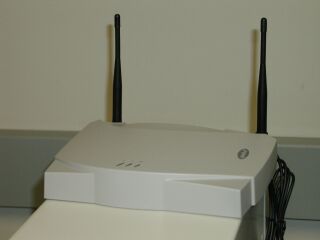Below is a general description of the research projects on-going at DISCOVER Lab. Some of them are projects we are planning for the coming academic year. As the year progresses, we may add more details regarding each topic.
Research and development of our video conferencing algorithm, CU30, has been the central focus of DISCOVER Lab. With CU30´s incorporation into the OpenH323 specification, an open source implementation of the H.323 protocol suite, we can leverage any OpenH323 compliant video conferencing software to provide the interface for our video codec. This can allow us to concentrate our research and development efforts more on our algorithm and its applications.
Traditionally, development of our video conferencing software has been on the MS Windows platform, under the name of CU30. In 1999, initiated by Aron Rosenberg, Andy Dodd and Ben Luk, the CU30 code was successfully ported to the Linux platform. This CU30 port was named qVIX. With the creation of a project on Sourceforge.net, our qVIX project officially became a part of the open source software community. Being one of the very few video conferencing applications that support the commonly used netcams (or webcams), qVIX quickly became quite popular among Linux users.
| ||||||||||||
Because different software drivers for multimedia support were used on the two platforms, Win CU30 and qVIX developments have been separate as they share only little common code, like the Huffman encoder; though their clients on both platforms are compatible.
Currently, we are in the process of bringing together the two developments with a common codebase that uses the SDL library, a cross-platform multimedia library for accesssing to graphics framebuffers and audio devices. Conversion to use SDL on the Linux side has been completed, we are in the last stages for Windows. When finished, our video conferencing application on both platforms will be called qVIX, while reserving CU30 only for the algorithm.
| ||||||||||||||||
For the coming year, we plan to enhance CU30 and qVIX with research on these topics:
![]() Open loop rate Control
Open loop rate Control
As opposed to closed loop systems, we would like to investigate on using an open loop to adaptively adjust the frame rate based on the network´s status.
![]() Audio support and audio compression with CU30
Audio support and audio compression with CU30
If you have used qVIX, you would know. The fact is that there is currently no audio support on qVIX. (The TV spot was done with a phone.) Actually, there is, but the code uses only drivers that work on certain sound cards. There has been research on this topic with the use of GSM codecs or a modified version of CU30 for audio.
![]() Enhancements to the quantizer
Enhancements to the quantizer
The quantizer is an important part of the CU30 algorithm, as it greatly determines the quality of the transmitted video signals. More work can be done in this area, especially on aspects related to foreground (eg. the speaker´s face - intense movements) and background (static to no movement) pixel quantizing.
![]() Browser plugin support for qVIX
Browser plugin support for qVIX
A new area in our development, but as qVIX users proliferate a web browser based plugin is naturally called for.
![]() Feedback in data stream and two-way control messaging
Feedback in data stream and two-way control messaging
A more network related study on the effects of providing feedback of the channel´s status and the use of more complicated two-way control messaging mechanism.
![]() Encryption in the data stream
Encryption in the data stream
This involves investigating possible security loop-holes in the current CU30/qVIX architecture and formulating solutions, like data encryption, to combat them.
![]() BREW based Video conferencing
BREW based Video conferencing In May 2001, Qualcomm officially released its development platform for 3G cellular networks, BREW (Binary Runtime Environment for Wireless) at the BREW 2001 conference. It was enthusiastically received by the industry every since. This is understandable because with BREW, developers can create applications for any Qualcomm CDMA handsets without requring the developer to have the chip system´s source code or relationship for a manufacturer.
In May 2001, Qualcomm officially released its development platform for 3G cellular networks, BREW (Binary Runtime Environment for Wireless) at the BREW 2001 conference. It was enthusiastically received by the industry every since. This is understandable because with BREW, developers can create applications for any Qualcomm CDMA handsets without requring the developer to have the chip system´s source code or relationship for a manufacturer.
With this capability, development for 3G mobile networks in a research environment will become easier and more economic. Presently we are looking into the possibility of starting a CU30 development stream on the BREW, and thus the 3G mobile network, platform.
![]() High frame rate qVIX
High frame rate qVIX
With the advent of broadband networking, high data rate connections are becoming readily available. The constraint for providing low latency 30-frame video stream at a very low-bit rate that the CU30 algorithm was originally developed for does not apply to most workstations anymore. Work should be done on investigating how CU30 should be modified to leverage higher data rates.
As the theme of this website suggests, we believe we are coming to any age of palm-top computing. Initiated by Aron Rosenberg, DISCOVER Lab is very happy to receive Applied Data Systems´ support and donation for a joint development of a Linux-based 802.11b enabled handheld device that runs qVIX.
ADS is a embedded computer system manufacturer in Maryland that specializes in ARM-based single board computers (SBC). As part of the joint program, ADS has loaned us one Graphics Master, a development system on their SBC line, and will be donating us two Bitsy device, smaller battery-opearated SBC clients.
| ||||||||||||||||
| |||||||||||||
Our research was greatly benefited with
Symbol Technologies´ donation of WLAN equipment, as their equipment gives us a testbed for our software and also allows us to verify and compare results generated through simulations with actual experiments.You can read more about this if you visit our WLAN homepage, which was created for our lab members to share information on setting up a WLAN for their experiements.
Back to top
Our speech recognition group was established in 1998. Since then, the
group has been involved in various interesting areas, with contribution from
Ph.D. student research, M.Eng. projects and undergraduate projects. The
two major projects are:
(1) Speaker verification:
Speaker verification is one of the techniques in biometrics. As
"voiceprint", speech can be used to verify a person's claimed identity by
the use of a machine automatically. Speaker verification can be
classified into text-independent and text-dependent verification. Both
systems have been developed in our group based on Hidden Markov Model
(HMM) and Gaussian Mixture Model (GMM). This technique can be used in many
access-control applications, such as bank security, telephone transaction,
and computer login, etc.
(2) Keyword spotting:
Keyword spotting is trying to detect the words that we are interested in
from spontaneous conversational speech. It is much more computationally
efficient than a large vocabulary speech recognition system. The
corresponding response can be made based on the decision. A demo system
was developed for this technique. Keyword spotting can be used for
automatic information retrieval from large amount of recorded audio data.
Our work also includes some other projects, such as voice conversion and
speech synthesis. Some joint work has been done with the researchers in
IBM T.J. Watson research center. Multiple papers have been published in
ICASSP and ICSLP during recent years.

©Copyright 2001 DISCOVER Lab



